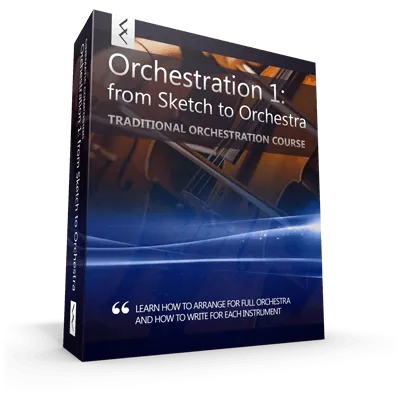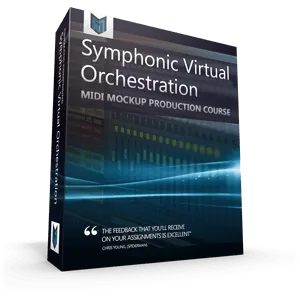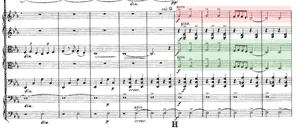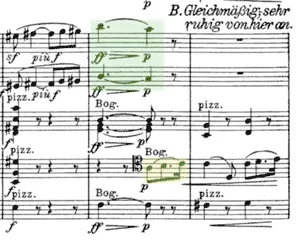** TO PREVENT DOUBLE CHARGES, DO NOT PRESS 'BACK', RELOAD OR CLOSE THIS PAGE**
One time Offer
Add Our Best-Selling Course...
" Orchestration 1: From Sketch To Orchestra" To Your Order
**Special Offer**
***NEXT LIVE DATE COMING SOON***
Learn & Master Orchestral Mockup Production Secrets From Award-Winning Composer Marc Jovani
With Our best-Selling Course...
"Symphonic Virtual Orchestration: Orchestral Mockup Production"
PRO Version
Get The 'Symphonic Virtual Orchestration' (PRO Version) Course at a 50% OFF
Get The ' Orchestration 1' Power Package Course at a 80% OFF
Regular Price: $997
This is a One Time Offer! Order Course Today For Only:
$197.00

Clicking here will charge your card $197
This Special Offer Ends In...
This Special Offer Ends On November 4th
Praise For The 'Symphonic Virtual Orchestration' Course

“Andy Hill has the ability to deconstruct and explain the process of writing film scores with extraordinary clarity, all the while imbuing the subject with a fervor that should, in my opinion, be reserved only for European football matches and Baptist revival meetings.”

You MUST get this – While most analytical books are written by academics, Andy was right there in the thick of things as a member of the Disney music department, while the majority of the scores in the book were actually being recorded. Not to mention, it is so alive with his mad passion for film music.

“Andy Hill is among the handful of penetrating minds and ears engaged in film music today.”

“Andy Hill’s ‘Scoring the Screen’ is, like its author, thoughtful, incisive and full of solidly interesting insights into the technique, craft and emotional magic of film scores and the composers who create them.”

“Andrew Hill displays the comprehensive knowledge, wisdom, and reverence required to provide informed and practical insight into the art and craft of composing screen music. His background as a practicing musician, Disney studio music-executive, and college-level educator enables him to intelligently—and sometimes amusingly—reveal the magic behind the film-composer’s curtain.”

“Andy presents his case that the finest composers to have worked in film over the last eighty years have contributed genuine masterpieces of music and drama to our culture. A film score must excel at both to be successful, and this is so beautifully illustrated in Hill’s elegant prose.Having produced new recordings of To Kill A Mockingbird — with Elmer Bernstein — and Patton — with Jerry Goldsmith — and examined these and other scores in great detail with the composers themselves, I found myself very moved by Hill’s like-minded analysis. Part of the film composer’s art is in fact to conceal the effort and the intellect that goes in to the creation of their scores. Hill thankfully lifts the veil. I am thrilled to see such a rare spotlight illuminating the artistry behind these masterworks.”
Flash 1-Day Pre Black Friday SaleOrder Andy Hill's Online Course Now And Save
Regular Price: $497
Get The Course Today For Only:
$97.00
This Special Offer Ends On
This Special Offer Ends On November 4th
Then the price will go up to $497
What's Inside Symphonic Virtual Orchestration?
(pRO Version)

The Symphonic Virtual Orchestration (Pro Version) is a 13 Module Course with over 130 video lessons to help you grow your orchestral mockup production skills.The entire course is designed to give you the information, resources, motivation – and most importantly – the accountability that is essential to your long-term success.
The Symphonic Virtual Orchestration (Pro Version) is a 13 Module Course with over 130 video lessons to help you grow your orchestral mockup production skills.
The entire course is designed to give you the accountability that is essential to your long-term success. It includes:
- A Weekly Live Video-Chat with your teacher and the rest of the students
- Assignments that get reviewed by your teacher
- A Private Community where you can interact with a community of over 700 composers
AND ALSO YOU GET...
- Live Masterclasses with professionals actively working in the industry
What's Inside Orchestration 1: From Sketch to Orchestra?
(power Package)

The Symphonic Virtual Orchestration (Pro Version) is a 13 Module Course with over 130 video lessons to help you grow your orchestral mockup production skills.The entire course is designed to give you the information, resources, motivation – and most importantly – the accountability that is essential to your long-term success.
The Orchestration 1: From Sketch To Orchestra (Power Package) is a 11 Module Course created to help you grow your orchestration skills.
The entire course is designed to give you the accountability that is essential to your long-term success. It includes:
- A Weekly Live Video-Chat with your teacher and the rest of the students
- A Private Community where you can interact with a community of over 4500 composers
- Live Masterclasses with professionals actively working in the industry
AND ALSO YOU GET...
- Hollywood Voicings - Instrumentation Secrets
130+ High-Impact Videos
Each lesson has been split into bite-sized chunks so you don't get overwhelmed with a flood of information. Take the course at your own pace, and really study the lessons as you apply the actionable lessons to your business.
Group Coaching
You will have the opportunity to work through any roadblocks you encounter during our Group Coaching Meetings. These are specific times the teachers at Cinematic Composing will be available inside of a video chat room where you can jump in to have your burning questions answered. Stay for as long as you'd like to listen in on other people’s questions, or leave as soon as you have your questions answered. These often turn into impromptu lessons as I elaborate on specific topics or start digging into someone's composing career.
Private Group With Everyone In The Community
Interact with other students who are going through some of your same struggles. Everyone inside of the community will be participating in group discussions inside our group. This will be a constant source of encouragement, accountability, community, and a place where lifelong friends will be forged.
Assignments Revisions On Video
You will receive feedback on your assignments with a video from your teacher. They will be always reviewed, no matter how late you post them.
Go At Your Own Pace
This special offer ends on .
BUT you can go at your own pace. Don’t need to follow the course’s schedule.
The course materials do not expire and you’ll have access to them for life. Even for the future course updates and improvements!
The duration is 6-8 weeks approx. You can do it a bit faster, or take as much time as you want/need.
Or you could even take advantage of the discount now, and be doing the course later.
The chat sessions get recorded and you can watch the replay whenever you want.
Also, you’ll have access to the course materials for life, as well as to the Facebook group AND the weekly chats.
You can join any weekly chat that you want, even if your course has finished.
Marc Teaches You...

18 Topics, 9 Videos, 3h+ of content IntroductionThe Instruments: the ViolinThe Instruments: the ViolaThe Instruments: the CelloThe Instruments: the ContrabassLeft Hand the StringsOpen StringsDouble, Triple and Quadruple StopsHarmonicsRight Hand: the BowRight Hand: Down and Up BowRight Hand: Bow TechniquesRight Hand: On the String Bow TechniquesRight Hand: Off the String TechniquesRight Hand: Techniques Depending on the Place on the StringRight Hand: Other TechniquesSubdivisionsConclusion

12 Topics, 1 Videos, 2h+ of content IntroductionThe Brass SectionThe Instruments: the French HornThe Instruments: the TrumpetThe Instruments: the Trombone FamilyThe Instruments: the TubaTechniquesTechniques: General ArticulationsTechniques: Other TechniquesMutesSubdivisionsConclusion
Get The 'Symphonic Virtual Orchestration' (PRO Version) Course at a 50% OFF
Get The ' Orchestration 1' Power Package Course at a 80% OFF
Regular Price: $997
This is a One Time Offer! Order Course Today For Only:
$197.00

Clicking here will charge your card $197
This Special Offer Ends In...
This Special Offer Ends On November 4th

12 Topics, 1 Video, 2h+ of content IntroductionThe Woodwind SectionThe Instruments: the Flute FamilyThe Instruments: the Oboe FamilyThe Instruments: the Clarinet FamilyThe Instruments: the Bassoon FamilyTechniquesTechniques: General ArticulationsTechniques: Other TechniquesSubdivisionsConclusion

28 Topics, 24 Videos, 5h+ of content IntroductionThe percussion sectionPitched/Memb: the TimpaniPitched/Idioph: the Mallet FamilyPitched/Idioph: the XylophonePitched/Idioph: the MarimbaPitched/Idioph: the VibraphonePitched/Idioph: the GlockenspielPitched/Idioph: the CrotalesPitched/Idioph: the Chimes (Tubular Bells)unPitched/Memb: the Snare DrumunPitched/Memb: the Bass DrumunPitched/Memb: the Concert Toms (Tom-toms)unPitched/Memb: the TimbalesunPitched/Memb: the BongosunPitched/Memb: the Congas (Tumbadoras)unPitched/Memb: the TambourineunPitched/Idioph: the CymbalunPitched/Idioph: the TriangleunPitched/Idioph: the Tam-tamunPitched/Idioph: the AnvilunPitched/Idioph: the WoodblocksunPitched/Idioph: the Temple-blocksunPitched/Idioph: the ClavesunPitched/Idioph: the CastanetsunPitched/Idioph: the MaracasunPitched/Idioph: the Whip (or Slapstick)Conclusion

9 Topics, 3 Videos, 2h+ of content IntroductionThe HarpHarp: TechniquesOrchestral Keyboard InstrumentsThe PianoThe CelestaOrchestral Keyboard Instruments: Playing TechniqueOrchestral Keyboard Instruments: Common TechniquesConclusion

15 Topics, 3 Videos, 2h+ of content IntroductionThe influence of the harmonic seriesPartials, Overtones, and HarmonicsThe Harmonic Series and How It Affects the OrchestrationThe String SectionThe String Section: the FunctionsPerforming MelodiesPerforming CounterpointPerforming Homophonic TexturesPerforming RunsPerforming Patterns of AccompanimentDoubling Other SectionsCombinations Within the String SectionVoicing for StringsVoicing for Strings: Samples and Piano SketchesConclusion

14 Topics, 6 Videos, 2h+ of content IntroductionThe Brass SectionThe Brass Section: the FunctionsPerforming melodiesPerforming counterpointsPerforming homophonic texturesPerforming runsPerforming patterns of accompanimentDoubling other sectionsBringing the orchestra to a new dynamic levelCombinations within the Brass sectionVoicing for BrassVoicing for Brass: From Samples to Acoustic InstrumentsConclusion

13 Topics, 4 Videos, 3h+ of content IntroductionThe Woodwind SectionThe Woodwind Section: the functionsPerforming melodiesPerforming counterpointsPerforming homophonic texturesPerforming runsPerforming patterns of accompanimentDoubling other sectionsCombinations within the Woodwind sectionVoicing for WoodwindsWoodwinds: From the Sketch to the OrchestrationConclusion

10 Topics, 6 Videos, 3h+ of content IntroductionThe Percussion Section, Keyboards and HarpThe Percussion Section, Keyboards and Harp: the functionsFeaturing Musical MaterialPerforming AccompanimentsPerforming HitsRaising the Dynamic Level of the OrchestraDoubling other sectionsPercussion: From the Sketch to the OrchestrationConclusion

7 Topics, 3 Videos, 2h+ of content IntroductionLayers: Association and SeparationBalance (1)Balance (2): the familiesBalance (3): separation and balanceVoicing for a symphony orchestraConclusion

Cinematic Composing, LLC is not associated with Facebook or Facebook, Inc.
FOR SUPPORT ISSUES OR QUESTIONS, PLEASE EMAIL US AT [email protected]
Copyright © 2025• Cinematic Composing • A Cinematic Composing LLC Brand • All Rights Reserved • Lake Forest, CA
Marc Teaches You...

10 Topics, 12 Videos, 2h+ of contentFirst StepsIntroduction: Synthestration. Tactics for a good soundDifference between Samples and Real OrchestraBasics: Recording DynamicsBalancePanningLayers: Distributing your Musical ideasVolume: 7, 11, Kontakt, Audio, Gain, etcKeyswitchesEqualizationAnd so much more...

8 Topics, 11 Videos, 3h+ of contentUsing Templates to Boost ProductivityRoutingSmall & Big Templates. Pros & ConsMinimal set-upModular Templates (Sonar & Cubase)Organization: Groups, Kontakt Instances, Buses, StemsReverbsComputer Specs

13 Topics, 14 Videos, 3h+ of contentReady-to-go Tracks: Configured and pre-routedGetting a Tight & Powerful Orchestral SoundOrchestrating Percussion Beds: balance, panning, layersSequencing a Percussion Bed: step by stepEnsemble Patches: benefits and when to use themStrings Long Sequencing: big cinematic soundSequencing Trumpets: the right wayHorn Patches: for an epic cinematic soundTremolo strings: very good sounding articulation usually underusedLow Staccato Strings: for an epic cinematic soundHorn Patches: for an epic cinematic sound

10 Topics, 11 Videos, 2h+ of contentSequencing Fast Strings - Three ApproachesStrings Measured Tremolos/StaccatosTimpani as a Main Orchestral Percussion InstrumentBlending Percussion and Orchestral PartsBlending Choir and OrchestraCompressing VelocitiesImporting MIDI data from Score Editor. A good idea?Sketching Within your SequencerAnd so much more...

8 Topics, 10 Videos, 2h+ of contentExporting StemsAnalog SaturationReverb, E.Q.CompressionAutomation (where the Magic Happens)Bonus: A good mix cannot fix arranging/composing mistakes

17 Topics, 17 Videos, 2h+ of contentMixing - Overview SectionsMixing each Section - High Strings, Low Strings, Strings AutomationHorns, Trumpets, Choirs, Brass Ensemble, Flute, Electric BassHigh Percussion, Mid & Low Percussion, Piano, Celesta, HarpConnecting ReverbMixed Track

6 Topics, 7 Videos, 1h+ of contentExpanding Mixing DepthExpanding Mixing Depth - ReverbsExpanding Mixing Depth - DelaysExpanding Mixing Depth - FXExpanding Mixing Depth - MaxxBassLearning from the pros

4 Topics, 4 Videos, 1h+ of contentMastering overviewMastering - E.Q., Analog saturation, Dynamics, Exciter, Imaging,Maximizer, AutomationMastered TrackBonus Video - Mastering with standard (non UAD) plugins

6 Topics, 8 Videos, 2h+ of contentIntroduction: Composing Workflow for Consistent Good ResultsEfficiency. Workflow overview1 min. Track under 1h: Introduction1 min. Track under 1h: Composing1 min. Track under 1h: Mixing1 min. Track under 1h: Mastering

4 Topics, 4 Videos, 1h+ of contentIntroductionTom HolkenborgHarry Gregson-WilliamsJohn Powell

10 Topics, 10 Videos, 6h+ of contentThriller/Spy/ComedyRomantic Love Ballade - Part 1Romantic Love Ballade - Part 2Grand Orchestral Trailer - IntroGrand Orchestral Trailer - ComposingGrand Orchestral Trailer - MixingGrand Orchestral Trailer - MasteringAction/Adventure - SynthestrationAction/Adventure - Mixing 1Action/Adventure Mixing 2

3 Topics, 2h+ of contentBasic Desk SchematicsComposer Desk Under $70Minimal Gear and How to Distribute It in Your Desk
Plus, you'll learn to compose in these styles...
Thriller, Spy, Comedy, Romantic Love Ballade, Sadness, Drama, Orchestral Trailer, Action, Adventure...
*included with the SVO + Film Music Cliches
Also, Learn How To Mixing & Master Orchestral Mockups...*
Mixing:
Basics: Exporting Stems, Analog Saturation, Reverb, E.Q., Compression, Automation (where the Magic Happens)...
Mixing each section: Mixing Strings Stems, Mixing Brass/WW Stems, Mixing Percussion, Mixing other instruments and sections, Synths...
Expanding Mixing Depth: Reverbs, Delays, FX, MaxxBass
Bonus: Learning from the pros (commercial tracks stems)
*included with the Power Package
Mastering:
E.Q., Analog saturation, Dynamics, Exciter, Imaging, Maximizer, Automation
*included with the Power Package
And so much more...
Praise For The 'Symphonic Virtual Orchestration' Course

“Andy Hill has the ability to deconstruct and explain the process of writing film scores with extraordinary clarity, all the while imbuing the subject with a fervor that should, in my opinion, be reserved only for European football matches and Baptist revival meetings.”

You MUST get this – While most analytical books are written by academics, Andy was right there in the thick of things as a member of the Disney music department, while the majority of the scores in the book were actually being recorded. Not to mention, it is so alive with his mad passion for film music.

“Andy Hill is among the handful of penetrating minds and ears engaged in film music today.”

“Andy Hill’s ‘Scoring the Screen’ is, like its author, thoughtful, incisive and full of solidly interesting insights into the technique, craft and emotional magic of film scores and the composers who create them.”

“Andrew Hill displays the comprehensive knowledge, wisdom, and reverence required to provide informed and practical insight into the art and craft of composing screen music. His background as a practicing musician, Disney studio music-executive, and college-level educator enables him to intelligently—and sometimes amusingly—reveal the magic behind the film-composer’s curtain.”

“Andy presents his case that the finest composers to have worked in film over the last eighty years have contributed genuine masterpieces of music and drama to our culture. A film score must excel at both to be successful, and this is so beautifully illustrated in Hill’s elegant prose.Having produced new recordings of To Kill A Mockingbird — with Elmer Bernstein — and Patton — with Jerry Goldsmith — and examined these and other scores in great detail with the composers themselves, I found myself very moved by Hill’s like-minded analysis. Part of the film composer’s art is in fact to conceal the effort and the intellect that goes in to the creation of their scores. Hill thankfully lifts the veil. I am thrilled to see such a rare spotlight illuminating the artistry behind these masterworks.”
Flash 1-Day Pre Black Friday SaleOrder Andy Hill's Online Course Now And Save
Regular Price: $497
Get The Course Today For Only:
$97.00
This Special Offer Ends On
This Special Offer Ends On November 4th
Then the price will go up to $497
WAIT! Your Order Is Not Yet Complete...
Get The 'Film Scoring' course at a 50% OFF
**Special Offer Only For New Members**
Get the Film Scoring Course at a 50% OFF
Regular Price: $975
Get The Course Today For Only:
$497.00
clicking here will charge your card $497
This is the Cinematic Composing's "Composition for Film: A Study of Styles" course. This is an addition to Andy's course but it's not part of his course. This content is exclusive from Cinematic Composing and you won't find it at this price anywhere else.
This Special Offer Ends As Soon As We Release The Course
Once the course gets released the price will go up to $975
This Special Offer Ends In...
What's the course structure?
The course consists of weekly lessons, based on videos and PDFs. At the end of every lesson, there's an assignment. The course also includes:
- A Weekly Live Video-Chat with your teacher and the rest of the students
- Assignments that get reviewed by your teacher
- A Private Community where you'll post the assignments that will get reviewed and you can ask questions.
- Live Masterclasses with professionals actively working in the industry
At the end of the course, you'll get a Certificate of Completion.
Is Andy Teaching This Course?
No, he isn't. This is the Cinematic Composing's "Composition for Film: A Study of Styles" course. This is an addition to Andy's course but it's not part of his course.
This content is exclusive from Cinematic Composing and you won't find it at this price anywhere else.
Film Scoring Syllabus?
**MODULE 1**
- INTRODUCTION
- WHAT IS FILM MUSIC
- THE FUNCTION OF MUSIC IN FILM
- FUNDAMENTALS OF SCORING
- Film Music Is About Story
- The Internal Landscape
- Music As A Supportive Element
- Music As A Character
- Interacting with the Director
- Spotting Sessions
- First Viewing
- Finding the Emotional Content Of A Scene
- Where, When, Why
• The psychology of why we need music in a scene and where
- Ins And Outs - Entrances And Exits
• Pacing Considerations
• Highlighting Elements of A Scene
- Methods Of Change
- Instrumentation
- Density
- Harmonic Movement
- Rhythm
- Making connections
- Transitions
- Tension and release
- Less Is More
- Dialog Considerations
- Recognizing the importance and how to support it
- Getting out of the way
- SETTING UP YOUR FIRST CUE
• Markers
• Tempo
• Hit points and what not to hit
- Why — where is the real story
- When — No cartooning allowed, unless it is a cartoon!
**MODULE 2: STYLE - SLOW DRAMA**
- MAPPING THE LANDSCAPE OF THE SCENE
• Genre
• Emotion - Psychology and physiology of the scene
• Pacing
• Intensity
- STYLE ANALYSIS
• Historic
• Mid-Era
• Contemporary
- EXAMPLE CLIP 1
- EXAMPLE CLIP 2
- SCORE ANAYLYSIS
- HARMONY - COMMON CHORD PROGRESSIONS
- MELODY
- TEMPO
- INSTRUMENTATION/ORCHESTRATION/TEMPLATE
• Sample Libraries
- DAW WALKTHROUGH
- ASSIGNMENT
• Dramatic Scene to score
**MODULE 3: STYLE - DRAMATIC LOVE/EMOTION PART 1**
*Each of the following modules will have the same basic topics as above; the number styles of those modules will likely need refining*
MODULE 4: STYLE - DRAMATIC SADNESS/EMOTION PART 2
MODULE 5: STYLE - SUSPENSE
MODULE 6: STYLE - HORROR
MODULE 7: STYLE - ACTION/HIGH LEVEL INTENSITY
MODULE 8: STYLE - ACTION/MID LEVEL INTENSITY
MODULE 9: STYLE - HIGH ADVENTURE
MODULE 10: STYLE - FANTASY/EPIC HEROES
MODULE 11: STYLE - COMEDY
MODULE 12: STYLE - ETHNIC
MODULE 13: STYLE - ONE SIZE DOESN’T FIT ALL/ OTHER STYLES
**MODULE 14: TECHNICAL CONSIDERATIONS**
- RECORDING/MIDI
- DAW
- DELIVERY METHODS
• Stems
• Surround Considerations
• Interview with Simon Stevens; Mark Orton
**MODULE 15: LOGISTICS**
- COMPOSERS AND ORCHESTRATORS
- MUSIC EDITORS AND THEIR ROLES
- MUSIC SUPERVISORS
- SCORE/PART PREPARATION
- RECORDING SESSIONS
- OTHER LOGISTICS AND COSTS
Get the Film Scoring Course at a 50% OFF
Regular Price: $975
Get The Course Today For Only:
$497.00
clicking here will charge your card $497
This is the Cinematic Composing's "Composition for Film: A Study of Styles" course. This is an addition to Andy's course but it's not part of his course. This content is exclusive from Cinematic Composing and you won't find it at this price anywhere else.